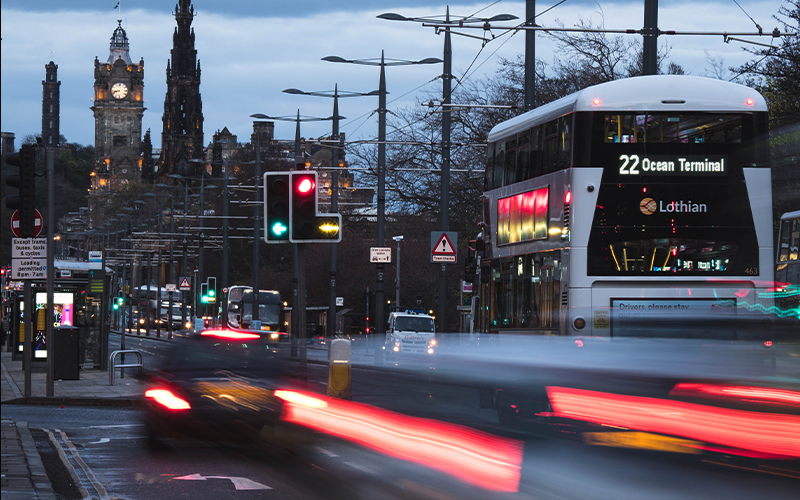The Ultimate Guide to Edinburgh's Low Emission Zone for Taxi drivers

Drive a taxi or run a taxi business in Edinburgh? Find out everything you need to know about the new Low Emission Zones (LEZs), so you aren’t caught off guard.
- Low Emission Zones are in place in Edinburgh city centre in a bid to clean up air pollution.
- Taxi and Private Hire drivers could face fines for driving a non-compliant vehicle in these areas.
- Penalty charges will be enforceable in Edinburgh from June 2024.
Table of Contents
1. What is Edinburgh’s Low Emission Zone (LEZ)?
3. How does Edinburgh’s Low Emission Zone work?
4. What are the emission standards in Edinburgh's Low Emission Zone for taxi drivers?
5. What happens if I breach Edinburgh's Low Emission Zone as a taxi driver?
6. What taxi vehicles are compliant with the Edinburgh LEZ?
7. Are there grants for getting a compliant vehicle in Edinburgh?
8. What to consider as a taxi driver?
9. How will this affect my taxi business?
What is Edinburgh's Low Emission Zone (LEZ)?
The Edinburgh Low Emission Zone is an area where only certain vehicles can drive through. Vehicles must meet a specific set of requirements or drivers will face a penalty charge.
The LEZ has been introduced to improve air quality in the city centre. Other zones have been rolled out across Scotland in Aberdeen, Dundee, and Glasgow.
When does the low emission zone start?
In Edinburgh, the low emission zone came into effect on 31st May 2022, but there is a two-year grace period. This gives regular drivers and taxi drivers the opportunity to upgrade their vehicle and avoid a penalty charge.
This means it will be enforced from 1st June 2024 and penalty charges will apply to non-compliant vehicles.
How does Edinburgh's Low Emission Zone work (LEZ)?
Automatic Number Plate Recognition (ANPR) is used throughout the zone. Cameras use data from national and local vehicle licensing databases to detect non-compliant cars.
Low Emission Zones operate all year round, including bank holidays such as Christmas Day and Boxing Day.
Stationary vehicles within these zones are not subject to LEZ standards.
What are the emission standards in Edinburgh's Low Emission Zone for taxi drivers?
Entry into Low Emission Zones for taxi drivers is based on the Euro emission engine classification standards set out below:
- Euro 6 for petrol or diesel taxis and private hire vehicles
The zone covers 1.2 square miles in the city centre of Edinburgh. It spans from Queen Street in the New Town to the other side of the Meadows on Melville Drive. From the east, it stretches from Abbey Hill to Palmerston Place in the west end.
What happens if I breach Edinburgh's Low Emission Zone as a taxi driver?
As a taxi driver, if you are found to be driving a non-compliant taxi in the low emission zone, you will be issued a Penalty Charge Notice (PCN).
The first penalty charge is set at £60 and if paid within 14 days, will be reduced by 50%.
For each subsequent breach of the rules found in the same zone, the penalty charge amount will double.
There is a £480 penalty charge cap for cars and light goods vehicles, and £960 for minibuses, buses, coaches, and HGV’s.
What taxi vehicles are compliant with the Edinburgh LEZ?
Any taxi that meets Euro 6 emission standards is considered compliant in Edinburgh’s Low Emission Zone.
At The Taxi Centre, we have a huge range of new taxis for sale to help you meet the emissions criteria. We also stock a selection of electric taxis such as the Kia Niro EV and hybrid taxis including the Toyota Corolla and LEVC TX taxi.
Are there grants for getting a compliant vehicle in Edinburgh?
Worried about your future of taxi driving in Edinburgh city centre? Don't worry, there are several grants available to help you make the switch to a low emission taxi.
The Switched On Taxis Loan is available to drivers who operate in Scotland. Businesses can use this help to buy an electric taxi or hackney cab which can often be costly.
The interest-free loan which is repayable over six years is open to operators and owners of hackney cabs. As well as private hire taxi drivers.
Limited companies can borrow a maximum of £150,000 for a new vehicle and £90,000 for a used vehicle.
Sole traders or partnerships can borrow a maximum of £75,000 for a new vehicle and £75,000 for a used vehicle.
There's also the Plug-in Taxi Grant (PiTG) offered by the government. The grant offers taxi drivers up to £7,500 off the cost of a new purpose built taxi.
The government has also pledged to improve charging infrastructure. Over 400 charging points and 150 rapid charging points are set to be rolled out for electric taxis.
At the moment, the Plug-in Taxi Grant (PiTG) is expected to be available until at least 2024.
Find out more about the grants available to taxi drivers.
What to consider as a taxi driver?
It’s important to check if your taxi meets the Low Emission Zone standards before it’s too late. You should also start to familiarise yourself with the area that the LEZ covers.
Find out if your vehicle is compliant by using the LEZ vehicle checker.
How will this affect my taxi business?
If your taxi already meets Low Emission Zone standards, there’s nothing to worry about. It won't have any impact on your business.
However, if your taxi is slightly older and doesn’t meet the criteria, it's worth considering an upgrade to avoid penalty charges.
